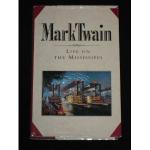Natchez, like her near and far river neighbors, has railways now, and is adding to them—pushing them hither and thither into all rich outlying regions that are naturally tributary to her. And like Vicksburg and New Orleans, she has her ice-factory: she makes thirty tons of ice a day. In Vicksburg and Natchez, in my time, ice was jewelry; none but the rich could wear it. But anybody and everybody can have it now. I visited one of the ice-factories in New Orleans, to see what the polar regions might look like when lugged into the edge of the tropics. But there was nothing striking in the aspect of the place. It was merely a spacious house, with some innocent steam machinery in one end of it and some big porcelain pipes running here and there. No, not porcelain—they merely seemed to be; they were iron, but the ammonia which was being breathed through them had coated them to the thickness of your hand with solid milk-white ice. It ought to have melted; for one did not require winter clothing in that atmosphere: but it did not melt; the inside of the pipe was too cold.
Sunk into the floor were numberless tin boxes, a foot square and two feet long, and open at the top end. These were full of clear water; and around each box, salt and other proper stuff was packed; also, the ammonia gases were applied to the water in some way which will always remain a secret to me, because I was not able to understand the process. While the water in the boxes gradually froze, men gave it a stir or two with a stick occasionally—to liberate the air-bubbles, I think. Other men were continually lifting out boxes whose contents had become hard frozen. They gave the box a single dip into a vat of boiling water, to melt the block of ice free from its tin coffin, then they shot the block out upon a platform car, and it was ready for market. These big blocks were hard, solid, and crystal-clear. In certain of them, big bouquets of fresh and brilliant tropical flowers had been frozen-in; in others, beautiful silken-clad French dolls, and other pretty objects. These blocks were to be set on end in a platter, in the center of dinner-tables, to cool the tropical air; and also to be ornamental, for the flowers and things imprisoned in them could be seen as through plate glass. I was told that this factory could retail its ice, by wagon, throughout New Orleans, in the humblest dwelling-house quantities, at six or seven dollars a ton, and make a sufficient profit. This being the case, there is business for ice-factories in the North; for we get ice on no such terms there, if one take less than three hundred and fifty pounds at a delivery.




